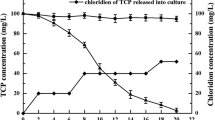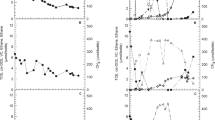Abstract
Trichloroethene (TCE) can undergo natural attenuation within wetland environments, particularly by oxidative processes that occur in the vegetated subsurface. The goal of this study was to evaluate TCE degradation potential through aerobic cometabolism by methane-oxidizing microorganisms associated with the roots of wetland plant species, Carex comosa and Scirpus atrovirens. The degradation experiments were conducted in 2.4 L Teflon microcosms with 15 g of washed, soil-free roots and amended with methane (2.1 mg/L), oxygen (8 mg/L), and TCE (three enrichment cycles without TCE and four cycles at 150 μg/L, one cycle at 600 μg/L, and one cycle at 900 μg/L of TCE). Our results indicated that methane-oxidizing activity and TCE degradation potential were comparable for the plant species investigated. The initial rates of methane degradation with TCE amendments varied between 0.21 and 0.30 mg L–1 d–1 for Carex comosa, and between 0.14 and 0.25 mg L–1 d–1 for Scirpus atrovirens. The average TCE mass removal per cycle varied between 24 and 32%, and the overall transformation yield was 0.0004 mmol TCE/mmol CH4 for both plant species. This study suggests that wetland plants can play an important role in the natural attenuation of TCE in contaminated aquatic environments.

Similar content being viewed by others
References
Alvarez-Cohen L, Speitel GE (2001) Kinetics of aerobic cometabolism of chlorinated solvents. Biodegradation 12:105–126
Amon JP, Agrawal A, Shelley ML, Opperman BC, Enright MP, Clemmer ND, Slusser TJ, Lach JD, Sobolewski TA, Gruner WE, Entingh AC (2007) Development of a wetland constructed for the treatment of groundwater contaminated by chlorinated ethenes. Ecological Engineering 30:51–66
Anderson JE, McCarty PL (1997) Transformation yields of chlorinated ethenes by a methanotrophic mixed culture expressing particulate methane monooxygenase. Applied and Environmental Microbiology 63:687–693
ATSDR (1997) Toxicological Profile for Trichloroethylene (Update). Atlanta, GA
Bankston JL, Sola DL, Komor AT, Dwyer DF (2002) Degradation of trichloroethylene in wetland microcosms containing broad-leaved cattail and eastern cottonwood. Water Research 36:1539–1546
Bosse U, Frenzel P (1997) Activity and distribution of methane-oxidizing bacteria in flooded rice soil microcosms and in rice plants (Oryza sativa). Applied and Environmental Microbiology 63:1199–1207
Bosse U, Frenzel P (1998) Methane emissions from rice microcosms: the balance of production, accumulation and oxidation. Biogeochemistry 41:199–214
Burris DR, Delcomyn CA, Smith MH, Roberts AL (1996) Reductive dechlorination of tetrachloroethylene and trichloroethylene catalyzed by vitamin B-12 in homogeneous and heterogeneous systems. Environmental Science & Technology 30:3047–3052
Calhoun A, King GM (1997) Regulation of root-associated methanotrophy by oxygen availability in the rhizosphere of two aquatic macrophytes. Applied and Environmental Microbiology 63:3051–3058
Calhoun A, King GM (1998) Characterization of root-associated methanotrophs from three freshwater macrophytes: Pontederia cordata, Sparganium eurycarpum, and Sagittaria latifolia. Applied and Environmental Microbiology 64:1099–1105
Chang HL, Alvarez-Cohen L (1995) Transformation capacities of chlorinated organics by mixed cultures enriched on methane, propane, toluene, or phenol. Biotechnology and Bioengineering 45:440–449
Chang WK, Criddle CS (1997) Experimental evaluation of a model for cometabolism: prediction of simultaneous degradation of trichloroethylene and methane by a methanotrophic mixed culture. Biotechnology and Bioengineering 56:492–501
Chanton J, Whiting G, Blair N, Lindau C, Bollich P (1997) Methane emission from rice; stable isotopes, diurnal variations, and CO2 exchange. Global Biogeochemical Cycles 11:15–27
Chen WM, Chang JS, Wu CH, Chang SC (2004) Characterization of phenol and trichloroethene degradation by the rhizobium Ralstonia taiwanensis. Research in Microbiology 155:672–680
Fogel MM, Taddeo AR, Fogel S (1986) Biodegradation of chlorinated ethenes by a methane-utilizing mixed culture. Applied and Environmental Microbiology 51:720–724
Ginestet P, Audic J-M, Urbain V, Block J-C (1998) Estimation of nitrifying bacterial activities by measuring oxygen uptake in the presence of the metabolic inhibitors allylthiourea and azide. Applied and Environmental Microbiology 64:2266–2268
Gossett JM (1987) Measurement of henrys law constants for C1 and C2 chlorinated hydrocarbons. Environmental Science & Technology 21:202–208
Inoue TM, Tsuchiya T (2008) Interspecific differences in radial oxygen loss from the roots of three Typha species. Limnology 9:207–211
Kassenga GR, Pardue JH, Blair S, Ferraro T (2003) Treatment of chlorinated volatile organic compounds in upflow wetland mesocosms. Ecological Engineering 19:305–323
King GM (1994) Associations of methanotrophs with the roots and rhizomes of aquatic vegetation. Applied and Environmental Microbiology 60:3220–3227
Kocamemi BA, Cecen F (2007) Kinetic analysis of the inhibitory effect of trichloroethylene (TCE) on nitrification in cometabolic degradation. Biodegradation 18:71–81
Lide DR, Frederikse HPR (1995) CRC handbook of chemistry and physics, 76th edn. CRC Press, Inc., Boca Raton
Little CD, Palumbo AV, Herbes SE, Lidstrom ME, Tyndall RL, Gilmer PJ (1988) Trichloroethylene biodegradation by a methane-oxidizing bacterium. Applied and Environmental Microbiology 54:951–956
Lorah MM, Olsen LD (1999) Natural attenuation of chlorinated volatile organic compounds in a freshwater tidal wetland: field evidence of anaerobic biodegradation. Water Resources Research 35:3811–3827
Neill C (1995) Seasonal flooding, nitrogen mineralization and nitrogen-utilization in a prairie marsh. Biogeochemistry 30:171–189
Pankow JF (1991) Aquatic chemistry concepts. CRC Press, Inc., Boca Raton
Popp TJ, Chanton JP, Whiting GJ, Grant N (2000) Evaluation of methane oxidation in the rhizosphere of a Carex dominated fen in north central Alberta, Canada. Biogeochemistry 51:259–281
Shim H, Ryoo D, Barbieri P, Wood TK (2001) Aerobic degradation of mixtures of tetrachloroethylene, trichloroethylene, dichloroethylenes, and vinyl chloride by toluene-o-xylene monooxygenase of Pseudomonas stutzeri OX1. Applied Microbiology and Biotechnology 56:265–269
Sullivan JP, Dickinson D, Chase HA (1998) Methanotrophs, Methylosinus trichosporium OB3b, sMMO, and their application to bioremediation. Critical Reviews in Microbiology 24:335–373
Tawney I, Becker JG, Baldwin AH (2008) A novel dual-compartment, continuous-flow wetland microcosm to assess cis-dichloroethene removal from the rhizosphere. International Journal of Phytoremediation 10:455–471
Van der Nat F, Middelburg JJ (1998a) Effects of two common macrophytes on methane dynamics in freshwater sediments. Biogeochemistry 43:79–104
Van der Nat F, Middelburg JJ (1998b) Seasonal variation in methane oxidation by the rhizosphere of Phragmites australis and Scirpus lacustris. Aquatic Botany 61:95–110
Weiss JV, Emerson D, Megonigal JP (2005) Rhizosphere iron(III) deposition and reduction in a Juncus effusus L.-dominated wetland. Soil Science Society of America Journal 69:1861–1870
Wind T, Conrad R (1997) Localization of sulfate reduction in planted and unplanted rice field soil. Biogeochemistry 37:253–278
Acknowledgments
This research was funded in part by the United States Environmental Protection Agency (EPA) through Greater Research Opportunities (GRO) fellowship to the first author (CLP). EPA has not officially endorsed this article and the views expressed herein may not reflect the views of the EPA. This research is part of a larger ongoing study to characterize biodegradation and fate of chlorinated ethenes in an experimental wetland, which has been supported by a continuing annual funding from Air Force Institute of Technology, Wright-Patterson Air Force Base, Ohio, through M.L. Shelley. We sincerely thank D.F. Cipollini for help with statistical analysis, M.N. Goltz for expert assistance, J.P. Amon for field guidance with wetland plants, and S.J. Tritschler for support with data collection.
Author information
Authors and Affiliations
Corresponding author
Electronic Supplementary Material
Below is the link to the electronic supplementary material.
ESM 1
(PDF 264 kb)
Rights and permissions
About this article
Cite this article
Powell, C.L., Agrawal, A. Biodegradation of Trichloroethene by Methane Oxidizers Naturally Associated with Wetland Plant Roots. Wetlands 31, 45–52 (2011). https://doi.org/10.1007/s13157-010-0134-7
Received:
Accepted:
Published:
Issue Date:
DOI: https://doi.org/10.1007/s13157-010-0134-7




